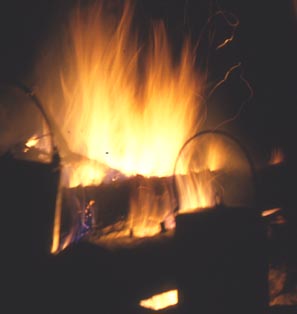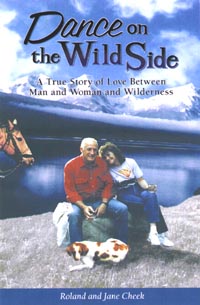a weblog sharing info on outdoor skills and campfire musing by a guy who spends a bunch of time in pursuit of both
CULTURE
WHERE -
TALES ARE TOLD OF
Welcome to Roland Cheek's Weblog
Roland is a gifted writer with a knack for clarifying reality. Looking forward to more of his wisdom
- Carl Hanner e-mail
Those who have packed far up into grizzly country . . . know that the presence of even one grizzly on the land elevates the mountains, deepens the canyons, chills the winds, brightens the stars, darkens the forests, and quickens the pulse of all who enter it.
- John Murray writing in The Great Bear
To access Roland's weblog and column archives
Tip o' the Day
Most info handed out by official agencies relative to human activities in grizzly country is a whole bunch of "don'ts". Even most of their "dos" seem to me like "don'ts" in disguise.
"Do hike in groups," actually says, "Don't hike alone."
"Do hang your food ten feet high and four feet out from the bole of a tree," actually says, "Don't leave your food piled within reach of a bear, you dork!"
Personally I like my own set of "dos." But my "dos" comes with certain elements of risk. For instance, I've been known to hike alone. I'm also pleased to hike (or ride) with compatible companions. But if I have the opportunity to go and can find no one to accompany me, then I'll go it alone -- and be glad! After all, at my advancing age, it's entirely possible that some day my heart or lungs or legs or prostrate will say "To hell with it" and I'll wish I'd climbed a few more ridges or floated a few more rivers.
On the other hand, if you are fearful of the great unknown and wish only a risk-free environment, then by all means stay ensconced in your townhouse high rise, throw your four deadbolts on the front door each evening, lock your windows (including the safety latches), draw your blinds, close your drapes and turn on your TV to the Discovery channel where you'll find what you missed and I found.
Are there risks from pursuing adventure amid my mountains? Of course. I was once in a seven-person hiking group who encountered a grizzly bear sow with two cubs. Boy, was that dangerous -- for the grizzly! She could hardly get her cubs out of that huckleberry patch fast enough! I also once bumped into a sow grizzly with one cub while hiking alone. She wasn't nearly so swift in retreat -- not as swift as I would've been had I a place to go.
So, Roland, how'd it turn out? Well, you can go to my website: www.rolandcheek.comand read the first chapter of Learning To Talk Bear and find out. Suffice it to say, however, that 25 years after the incident, I'm sitting at my computer writing about it, so it couldn't have been too bad. And I'll bet the average reader poring over this weblog hasn't gone that long without experiencing some sort of fright on the freeway, or in his or her apartment building.
The point is to cut down on your risk by using commonsense and logic. Do drive defensively, Don't drink and drive. Do participate in a "neighborhood watch." Do think ahead.
You already do all the above? Good for you. So do I. It's just that my neighborhood and its trails aren't quite so dangerous as yours.
* * *
A weblog about an animal that is arguably the most powerful land carnivore on earth seems a perfect place to insert a plug for my two popular books on grizzly bears. First is Learning To Talk Bear -- our best selling title, now in its 5th printing.
GRIZZLY BEAR PARANOIA
A friend and I once discussed the paranoia some people feel toward grizzly bears. Doug had recently returned from Asia where he'd been on assignment for National Geographic. He told of floating down the Indus River in a skin kayak and watching 12-foot crocodiles slither from the bank into the muddy water, then drifting over the spot where the croc's bubbles rise to the surface.
"Scared? You bet! But the reason those crocs slide into the water at human approach is because its the only way they can survive."
Doug went on to compare grizzly bears to animals in the jungles of India: "There are 500-pound striped cats that blend perfectly with the vegetation, 12-foot cobras whose venom is so deadly it can kill you in 10-seconds, two-ton rhinos wandering the canebreaks that will charge you at the slightest sound, five-ton elephants that leaves just a grease spot if they step on you. Yet there are little brown men wandering those same jungles wearing nothing but a loincloth. And you know what? There are almost no tigers, no cobras, no rhinos, no elephants left. Yet some of us are worried about an occasional grizzly bear who wanders around looking for a huckleberry or two."
Why do people who live farthest from where bears roam fear them the most? Jane and I happened to be signing books at a store in Boise, Idaho when public hearings were being held on possible reintroduction of grizzly bears to the Selway-Bitterroot Wilderness, spanning the mountains between Idaho and Montana. We attended that evening's hearing and was flabbergasted at Idahoan paranoia.
For instance, a representative of an aeronautics association testified that Gem State backcountry aviation would be threatened if grizzly bears again roamed mountains near wilderness airstrips. By chance he was followed by a Tribal representative who brought chuckles by spreading his hands and saying: "Grizzly bears don't carry Surface-to-Air missiles."
Other speakers intimated the big bears were certain to consider schoolkids as essential ingredients in the food chain. An articulate Idaho state legislator and youth leader was vehement about the threat grizzlies would pose to their state's wilderness Boy Scout program. My mind wandered to the hundreds of Boy Scouts and Girl Scouts I'd encountered during my years as an outfitter in the Bob Marshall Wilderness. Why, I wondered would a transplanted Montana grizzly bear suddenly turn mean toward Gem State kids when there was no record of a single grizzly bear/Boy Scout encounter in the Treasure State?
Another speaker--this one testifying for a mining association--said grizzly bears would bring Idaho mining to a halt. Others suggested that folks believing grizzly bears belonged in the Bitterroots should be subjects of lawsuits should anyone ever be injured by a relocated bear or its descendants.
One testifier startled me by saying grizzly bears posed a real threat to innocent hunters. I laughed aloud, thinking it's the other way around. To my certain knowledge, dozens of Bob Marshall grizzly bears have died from hunters' guns, while but one Wilderness hunter--ever--was killed by a grizzly. And that was decades ago, after the hunter had already wounded the bear and was following its blood trail into a thicket.
In all honesty, it would be untrue that all emotion thrust forward as "fact" stemmed only from one side. One youthful speaker raised his voice to cry, "Anyone afraid of grizzly bears should be ashamed!"
I glanced quickly around to see if I was the only "shamed" person in the audience--I'll readily admit to being afraid of any beast who's bigger than me, stronger than me, tougher than me, and who might, in some sudden encounter, see me as a very great danger, something to defend against with terrifying force. Sometimes a measure of fear is a good tool to have in your bag when traveling where the great beasts are also wont to roam. Respect is another. So is caution. Experience helps, too, perhaps providing understanding of the habits and habitats of this tremendous animal. But fear to the point I wish to erase grizzlies from the face of this earth? Not on your life!
Grizzlies are magnificent creatures and I value my hundred-odd glimpses of them to be highlights of my outdoors lifetime. For me to wander mountains bereft of grizzly bears would somehow seem a second-class adventure. Mountains with grizzlies are higher, air fresher, water sweeter. And to know one lives in a land where the great bears still roams means I dwell in the very highest-class environment.
I found the Idaho emotional rhetoric fascinating about dangers to humans the bears pose, and how we can ill afford to tolerate them. Isn't it bewildering that more hysteria cames from folks dwelling where there are no grizzlies than from people who live where the bears hang around?
The Governor of Idaho, his Fish & Game Director, and the Gem State's entire Washington political delegation opposed Wilderness reintoduction. Montana, though also affected if reintroduction takes place in the Selway-Bitterroot, seems more savoir-faire, perhaps because most of our other mountain ranges are already home to the great beasts. While the average resident of small-town Idaho might be impelled toward running fits at thought of a grizzly bear in their nearby mountains, coffee shop conversation in a bunch of Montana towns turns on whether anyone has been privileged to spot a silvertip crossing the street yesterday?
Roland Cheek wrote a syndicated outdoors column (Wild Trails and Tall Tales) for 21 years. The column was carried in 17 daily and weekly newspapers in two states. In addition, he scripted and broadcast a daily radio show (Trails to Outdoor Adventure) that aired on 75 stations from the Atlantic seaboard to the Pacific Ocean. He's also written upwards of 200 magazine articles and 12 fiction and nonfiction books. For more on Roland, visit:
www.rolandcheek.com
Recent Weblogs
Tuesday, July 8, 2008
There's a bunch of specific info about Roland's books, columns, radio programs and archives. By clicking on the button to the left, one can see Roland's synopsis of each book, read reviews, and even access the first chapter of each of his titles. With Roland's books, there's no reason to buy a "pig in a poke."
for detailed info about each of Roland's books
Read Reviews
Read their first chapters
For interested educators, this weblog is especially applicable for use in environmental and government classes, as well as for journalism students.
Roland, of course, visits schools. For more information on his program alternatives, go to:
NEXT WEEK:
MURPHY RULES OUTDOORS ADVENTURE
www.campfireculture.com
Remember, Roland takes a lifetime of experience and adventure throughout the West into writing his Valediction For Revenge series; six books about the life of Jethro Spring, a young mixed-blood wanted for murder of the man responsible for killing his father and mother.
source links for additional info
to send this weblog to a friend
to tell Roland what you think of his Campfire Culture weblog
to visit Roland's newspaper columns and weblog archives
Loved your very scholarly book, Learning To Talk Bear . . . I will be in the area [Glacier Park] May 29 to Sept. 22 and would like to meet with you if possible. . . .
Chocolate Legs is also a popular book. Released three years after Learning To Talk Bear, Chocolate Leg is presently in its 3rd printing. Both books are, of course, timeless in the insider information they share about the great beasts and how we must learn their traits if we (and they) are to survive while sharing the highest quality habitats on earth.
Another book imparting info about the big bears is Roland's humorous, My Best Work is Done at the Office, a compilation of 20 years of his best newspaper columns and radio program scripts.
For details about these and other Roland Cheek books
There are two other important Roland nonfiction books set in the mountain wild country he loves so well. . . .
Dance On the Wild Side is the story of Jane's and Roland's lives as outfitters and guides in one of America's wildest and grandest wilderness areas. The book begins with them growing up next door in Oregon, then takes off from there for 50 years of hardship and peril, love and adventure.
The Phantom Ghost of Harriet Lou is the story of Roland's infatuation with America's second most charismatic creature -- elk.
Oh! And Roland writes Western Adventure novels set in the Old West.
Why not? He's lived the life!







